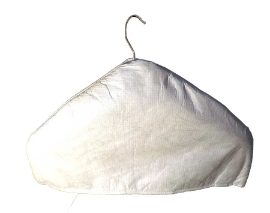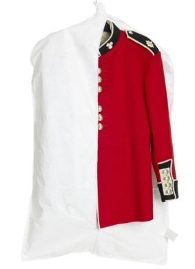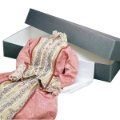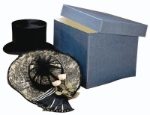Textile storage stresses and hang-ups
Preservation of valuable textiles such as wedding dresses, christening gowns, jackets, military uniforms, flags and banners is common place, not only in museums and archives, but in households worldwide. How are these precious textiles best stored? What are the main risks to textile storage?
What are the main risks to textile storage?
Don’t store your dirty linen in public
Before storing any costume or textile it’s important that any potential problems are isolated or removed.
Textiles should be clean before they are placed in storage. You may need to consult a trained conservator as to the best way of cleaning an item. Brushing and vacuuming (with low suction and with a screen) or washing in a conservation grade detergent, such as Orvus paste, are methods suitable for textiles that are in good stable condition. Fragile fabrics will require the attention of a conservator. Although the overall fabric may appear to be in good condition, threads used in stitching may be weak, caution is advised.
Soiling can be an open invitation to pest infestation. Any items which harbour pests, such as clothes moths, should be isolated and sealed in an inert polyethylene bag. It’s a good idea to monitor storage areas for pests, which if left unmonitored, could destroy a collection.
Acid issues
Any potential sources of acidity should be removed, this could include dry cleaning (or other identification) tags including the twine. Wooden hangers, or lining paper (unless you know it’s acid free) may also be part of the collection but must be removed prior to storage. Migrant acidity can damage fabrics causing them to weaken and break down over time.
Pins and badges should also be removed where possible to prevent corrosion from staining the fabric and prevent acid migration. Where these are of historical importance, retain them and keep them sealed in a polyethylene bag with the item from which they came. Garments may have integral metal components that cannot be removed, in this case, covering them independently in an acid-free tissue or linen will help prevent staining.
Flat out or riding the rail?
For items of clothing such as dresses and jackets, you can save a lot of space by hanging on a rail as opposed to storing in boxes. The choice should be made based upon the condition and or shape of the item.

Hanging out
Hangers can be used for costume storage provided that the garment isn’t fragile. Any hanger material in contact with the garment should be acid free. Wood, plastics (PVC) and metal can all cause damage through acid migration and should be covered.
Our padded Tyvek hanger covers are inert and fit over most standard clothes hangers. Their key function is that the padded cover increases the surface area of the hanger, reducing stress on the garment. Additional padding/wadding can be added to the hanger as required. Alternatively, you can attach padding or wadding to a hanger directly. It’s important, whichever method you choose, that the garment is adequately supported – too short or too long could add additional stresses.
In addition to supporting the garment when hanging, you will also need to protect it from dust, light and pests. Textiles require a breathable cover or bag, the airflow preventing condensation from forming as a result of the garment’s natural moisture content. Excess moisture could raise the micro-environment’s RH level, in-turn encouraging the growth of mould and  fungi. The cover (dress bag) should also be completely sealed to prevent access by pests, such as the dreaded clothes moth. We recommend Tyvek for this purpose, it’s inert, waterproof and breathable. Our Tyvek garment covers (bags) can be fully zipped up and are available in a range of sizes to suit dresses, jackets, coats and waistcoats. You could also consider a Tyvek rail cover which could cover a number of items, rather than individually covering. We also offer smaller bags for archival storage of shoes and boots, the archival shoe bags offer the same protection but are sealed using a drawstring, or hook and loop fastener.
fungi. The cover (dress bag) should also be completely sealed to prevent access by pests, such as the dreaded clothes moth. We recommend Tyvek for this purpose, it’s inert, waterproof and breathable. Our Tyvek garment covers (bags) can be fully zipped up and are available in a range of sizes to suit dresses, jackets, coats and waistcoats. You could also consider a Tyvek rail cover which could cover a number of items, rather than individually covering. We also offer smaller bags for archival storage of shoes and boots, the archival shoe bags offer the same protection but are sealed using a drawstring, or hook and loop fastener.
Why Tyvek?
Tyvek is a smooth, non-woven, mesh of polyethylene fibres. It’s soft but won’t tear, waterproof (1442r grade) but breathable, and it is inert. It’s ideal for archival storage full stop, but it’s great for protecting textiles. As well as prefabricated covers, Tyvek is also available in large roll form and is used around the world to drape over soft furnishings and other textiles. In a clean state, Tyvek doesn’t support the growth of fungi or bacteria and allows items to breath, preventing condensation. Tyvek has a blog post all of its own, if you're interested, it's here.
Boxing clever

Some items can only be safely stored in a box, particularly heavy or fragile items are best stored flat. Our large textile boxes provide an archivally safe storage option for dresses and other large textiles and costumes.
Textile boxes need to be 100% acid free, as does any tissue paper also used in the wrapping of the item. Remove any coloured tissue papers that an item may have originally been stored with to prevent dyes from transferring.
If an item needs to be folded in order to fit a box, it is best practice to ‘roll’ it, rather than folding it. Using acid free tissue paper or wadding, support the garment or textile inside the fold forming a ‘C’ shape preventing creasing. Before placing the item into the box, it’s a good idea to line it with tissue paper, this makes handling easier in the future.
Our large textile boxes do not contain any glues that can off gas or attract pests. The lids are the full depth of the box, excluding dust and light, and making them strong enough to be stacked without any risk to the contents.
Hats

Due to their dimensions, hats can be tricky to store in an archive other than in a box. Our hat boxes are made of robust 1300gsm archival box board with metal edges to protect the contents. There are many Hat boxes on the market which may well look prettier but are no good for archival storage. In order to protect and preserve the hat, the box and any support material must be acid free.
The environment
You can forget everything above if the environment isn’t right, mould is bad for you and your collection, and UV light can destroy textiles. Take a read of our blog posts on managing the storage environment:
Other notes
It’s good practice to wear gloves when handling textiles to prevent salts and oils from your skin soiling the item.
You may want to consider buying insect traps to monitor the storage area, you could prevent an infestation before it starts. You can read more here
We always advise consulting a professional conservator who will be able to help you make decisions on how to store and protect your valuable textiles.
Our range of textile storage products –
Click here.